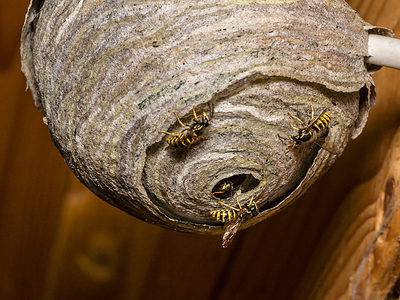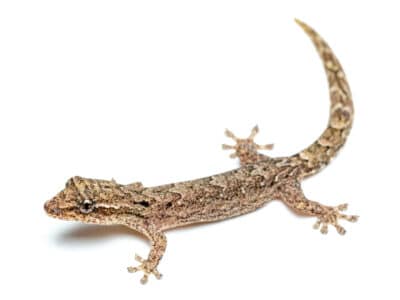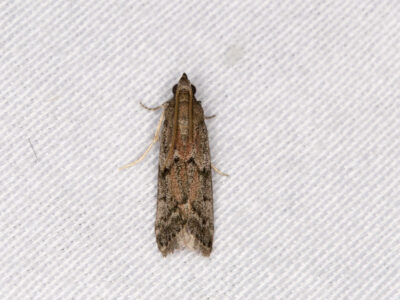More than 10 percent of eastern tiger snakes are blind in at least one eye.
Advertisement
Eastern Tiger Snake Scientific Classification
- Kingdom
- Animalia
- Phylum
- Chordata
- Class
- Reptilia
- Order
- Scaled Reptiles
- Family
- Elapid snakes
- Genus
- Notechis
- Scientific Name
- Notechis scutatus
Read our Complete Guide to Classification of Animals.
Eastern Tiger Snake Conservation Status
Eastern Tiger Snake Facts
- Prey
- Mice, rats, frogs, fish, insects
- Name Of Young
- Snakelets
- Group Behavior
- Solitary
- Fun Fact
- More than 10 percent of eastern tiger snakes are blind in at least one eye.
- Biggest Threat
- Forest fires, birds of prey
- Most Distinctive Feature
- Tiger-like stripes on their body
- Gestation Period
- 112 days
- Age Of Independence
- 0 days
- Litter Size
- 15-30
- Habitat
- Grasslands and coastal areas
- Predators
- Birds of prey, pythons
- Diet
- Carnivore
- Lifestyle
- Diurnal
- Favorite Food
- Frogs
- Location
- Eastern Australia
Eastern Tiger Snake Physical Characteristics
- Color
- Grey
- Black
- Olive
- Light-Brown
- Skin Type
- Scales
- Lifespan
- 5-15 years
- Venomous
- Yes
- Aggression
- Medium
View all of the Eastern Tiger Snake images!
“The eastern tiger snake is one of the most venomous snakes in the world! Their venom contains a deadly neurotoxin that can kill a full-grown adult if left untreated.“
Summary
The eastern tiger snake is ranked among the world’s top 15 most venomous and deadly snakes. This reptile is found in the mountain ranges and coastal areas of Australia. The eastern tiger snake is considered a subspecies of the tiger snake. These snakes spend most of their time on land, but they can also swim very well and climb trees, giving them lots of versatility when it comes to feeding.
5 Incredible Eastern Tiger Snake Facts
- Over 10% of all eastern tiger snakes are blind in at least one eye!
- Eastern tiger snakes can hold their breath underwater for as long as 10 minutes.
- They’re diurnal reptiles, meaning they are the most active during the day.
- Even though they are named for their tiger-like stripes, some eastern tiger snakes don’t even have stripes!
- Their mating season is in the spring. During this time, the male eastern tiger snakes fight one another for what could be as long as seven hours! The winner gets to mate with the female.
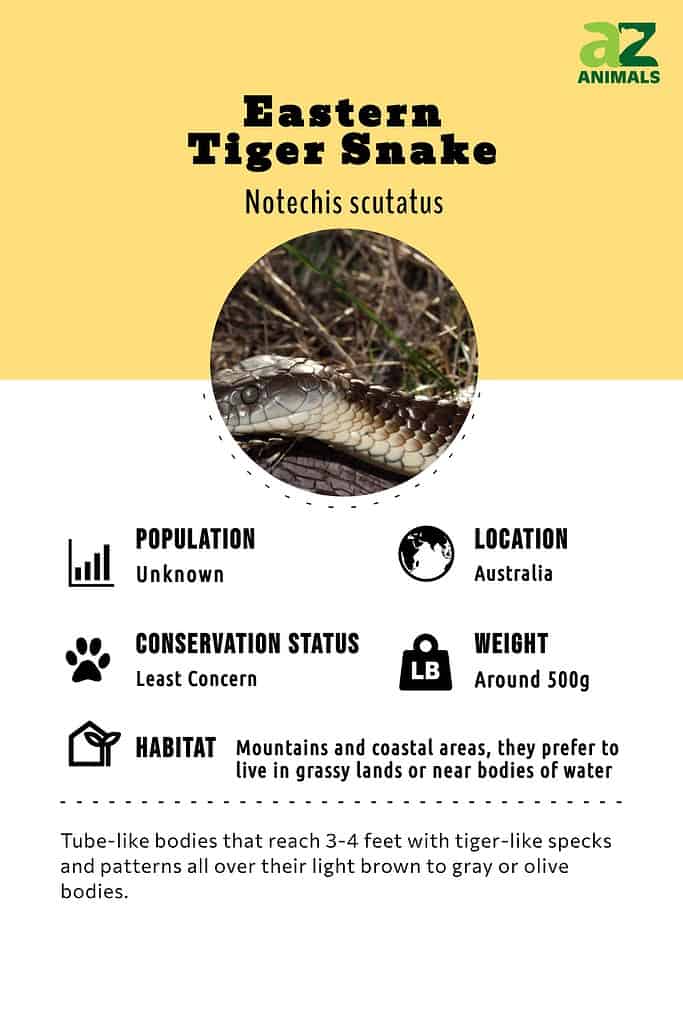
Scientific Name
The eastern tiger snake, or Notechis scutatus, belongs to the Elapid family of snakes and has fangs at the front of its mouth. There is some debate about whether or not there are other species related to the tiger snake, namely the Notechis ater. There also is confusion as to if there are subspecies, or if these variations are morphs of the snake.
History and Evolution
These snakes have specific genes not found in their Asian and African land-bound cousins. In fact, most experts believe that they came from marine animals or amphibians that evolved to suit the environmental conditions of Australia. It is also believed that the eastern tiger snake came to Australia by water. The present-day appearance of eastern tiger snakes, or the Notechis scutatus, results from several climates and sea-level changes over the past 10,000 years.
Appearance
This snake earned its name from the tiger-like specks and patterns all over their bodies. But this does not mean all of them to have the same tiger-like pattern. In fact, there have been reports of some eastern tiger snakes with no patterns. This can make identifying some tiger snakes difficult.
The average eastern tiger snake is about 3-4 feet long, or about as long as your average guitar! Their bodies are tube-like, with eyes on the side of their head. Their fangs are about one-fifth of an inch long.
The coloring of eastern tiger snakes can vary from light brown to gray or olive. The underparts are often lighter than the top of the body, featuring shades of off-white to yellow. Their face is often brighter in color as well. Due to a generic color scheme, these sub-species are often confused with the eastern brown snake that also inhabits similar regions of Australia. However, the main distinguishing feature is the black spot on the back of the eastern brown snake.
These animals have a lot of melanin in their skin, which gives them a dark color. The Australian sun is intense, so the eastern tiger snake’s dark color helps to protect it from harsh rays. The dark shades also provide camouflage so it can effectively hide from predators.

The underparts of an eastern tiger snake are often light in color, featuring shades of off-white or yellow.
©SunofErat_Matt_CCBY2.0 – License
Behavior
These snakes are shy and will not usually attack unless provoked. In most cases, they will slither away when they spot a human or large animal. However, if they feel threatened, they are one of the most dangerous animals out there, and you may be unable to escape a bite. When spotted, it’s best not to engage with these reptiles. Generally speaking, they are solitary creatures that prefer to live alone and only interact with other eastern tiger snakes during mating.
Habitat
They are found in different parts of Australia such as New South Wales, Queensland, Victoria, and Tasmania. Usually found in the mountains or coastal areas, these animals prefer to live in grassy lands or near bodies of water. Although they are land-dwelling creatures, they spend a lot of time in the water and are phenomenal swimmers.
They can also be found in wetlands, creeks, and near dams. Since they are cold-blooded, like all other reptiles, their body temperature is dependent on their environment, and their habitat plays a key role in their survival. They generally spend much of the day under the sun and retract to burrows, hollow logs, and other confined spaces to keep warm at night.
Diet
These venomous snakes are carnivorous animals that feed on small animals. To make their kill, they bite the small animal with their fangs. The venom quickly paralyzes and kills the small animal, and finally, the snake consumes the animal whole. They often sneak up on their prey, using their fast reflexes to make their capture.
It primarily feeds on small animals such as birds and frogs. They will also eat fish, tadpoles, and small mammals such as rats and squirrels. As the snake grows, it will begin to prey on larger animals such as toads or large fish. If frogs and birds are unavailable in their habitat, they will feed on just about any animal they can catch, including other snakes. They are best at catching animals in the water, as they are proficient swimmers. A common misconception is that eastern tiger snakes eat the eggs of other animals, but they do not generally eat eggs unless they are left with no other option.
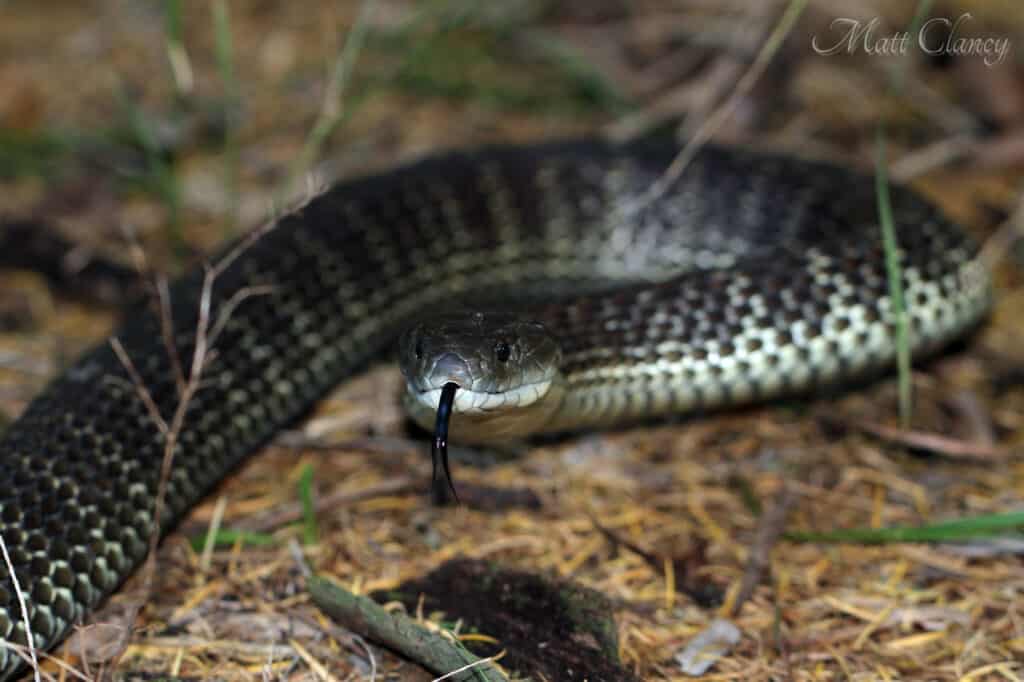
Eastern tiger snakes use their venom to paralyze their prey.
©SunofErat_Matt_CCBY2.0 – License
What Eats the Eastern Tiger Snake?
Large birds such as hawks, eagles, ibises, and kites hunt the eastern tiger snake. Larger snake species such as the olive python or Australian scrub python have also been known to eat them. They can also fall victim to certain parasites that may eventually kill them.
Predators and Threats
Its main predators are birds of prey such as eagles, hawks, ibises, and kites. They are also a target of parasites and can be killed as a result. Unfortunately, another possible threat to the survival of these animals is humans, who have routinely hunted these animals, causing a decrease in their population.
Deforestation and forest fires are also a threat to this species. The Australian bush fires of 2020 caused a massive decrease in many animals across the continent, including this snake. Luckily, their population is still stable and there is little concern for their extinction. Other potential threats to the eastern tiger snake are freezing temperatures, ticks, tapeworms, nematodes, and tongue worms.
Reproduction
It is a viviparous animal, meaning females keep their young within their bodies until they are born. The mating process first involves two males fighting one another until one of them wins. The winner then mates with the female. The mating process can last anywhere between three to seven hours.
The gestation period usually lasts 112 days. After this period, the mother gives birth to live young. The size of the litter is usually 15-30 snakes, each of which is 4-5 inches long. So far, the largest litter of eastern tiger snakes that’s ever been recorded is 70 snakes born at one time. Now, that is a lot of baby snakes! Females will generally reproduce every other year.
Babies
As mentioned, they usually give birth to 15-30 younglings at a time, and their little ones are known as snakelets. Even though they are typically born blind, snakelets are independent upon birth and left to fend for themselves.
The diet of the snakelets depends on the weather and their environment. Their diet can include small birds or mice, earthworms, bird eggs, slugs, leeches, amphibians, and insects. These animals shed their skin much more frequently as snakelets, but as adults, they still shed around four times a year.
Lifespan
Their lifespan is between 5-15 years, with an average of 10 years. However, these animals can also be prone to several common ailments due to exposure to parasites, like worms, ticks, and mites. The animal usually gets rid of these when they shed its skin. However, the parasites can infect their vital organs, which can be deadly.
Other common diseases that affect eastern tiger snakes are:
- Blisters on their scales.
- Respiratory disease.
- Septicemia (a toxic bacterial invasion of the snake body).
Population
While the exact number of eastern tiger snakes around the world is not known, the snake is known to have a large population in Australia, especially in the southern parts. The most common area to find easter tiger snakes is Victoria and Tasmania. The snake’s current conservation status is “least concern,” meaning there are plenty of the species in the wild and conservationists do not see any signs of population decline.
Related Animals
View all 117 animals that start with EEastern Tiger Snake FAQs (Frequently Asked Questions)
Are eastern tiger snakes carnivores, herbivores, or omnivores?
These snakes are carnivores. They feed on small animals such as birds, frogs, mice, and insects.
Is it legal to own an eastern tiger snake?
As the eastern tiger snake is highly venomous, most countries require a special permit to keep one as a pet.
Can eastern tiger snakes kill you?
Yes, they can. If you are bitten by the animal and do not seek medical care, there is a chance you might die from the venom. Fortunately, antidotes for its venom are widespread and well-known nowadays. So, if you seek medical care as soon as possible, you will likely survive the bite.
How long do eastern tiger snakes live?
Eastern tiger snakes generally live around 5-15 years in the wild.
Are eastern tiger snakes blind?
About six percent of eastern tiger snakes are blind in one eye, and an additional seven percent are fully blind in both eyes.
Are eastern tiger snakes aggressive?
Eastern tiger snakes do not normally attack unprovoked. So, if you see one, simply leave it alone.
Thank you for reading! Have some feedback for us? Contact the AZ Animals editorial team.
Sources
- Walk About Park, Available here: http://www.walkaboutpark.com.au/reptiles/eastern-tiger-snake
- Wildlife (1970) https://www.wildlife.vic.gov.au/ data/assets/pdf_file/0018/84114/Tiger-Snake.pdf
- IUCN Red List, Available here: https://www.iucnredlist.org/species/169687/83767147








